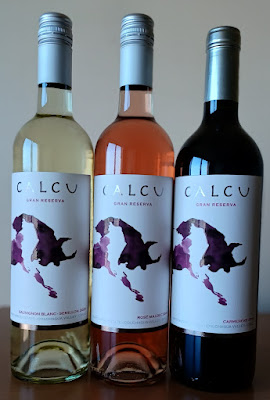Boizel, a six generation family enterprise, was founded in 1834 by a couple of local pastry chefs, Auguste Boizel and Julie Martin, who ventured into the Champagne business, after Julie inherited vineyards in the cities of Avize and Etoges.
The Boizel Champagne house, a negociant-manipulant, first sold their Champagnes locally, becoming one of the first houses to make and sell brut (dry) Champagne. Soon, their fame crossed all borders, first to the UK, then to Australia, Belgium, Germany, the Netherlands and NY. Boizel created their first Blanc de Blancs in 1929, and the Joyau (Jewel) line up in 1961. Their prestigious Cuvée "Sous Bois" (in wood) was released in 1990, and it was the first Champagne to be partially vinified in Burgundian second hand oak barrels. A practice that the winery still applies to 10% of their top wines today.
To make their wonderful line up, Boizel sources fruit from 7 hectares of their own vineyards located in Champagne's Avize and Le Mesnil-sur-Oger, these are complemented with fruit sourced from local growers. Their vintage wines are all aged in their cool, chalky cellars located underneath their tasting room in Epernay. The length of their aging varies according to each style, most of the NV wines are aged for 3 years, the Blanc de Blancs and Blanc de Noirs from 3 to 4. Vintage wines for up to 10 years while the Joyau de France line is aged for up to 15 years.
Boizel's Atelier 1834 entrance, their tasting room at Epernay, located at 46 Ave de Champagne.
Besides vinifying their wines in oak, I was surprised to find out that Boizel Champagnes have more Pinot Noir in their blends than any other champagnes (at least 50% or more vs the 33% usually found in other brands). This is true for most of their bottles including the NV, and except for their Blanc de Blancs, which is made solely from Chardonnay. Having a higher percentage of Pinot Noir, makes a huge difference in style, resulting in rich and bigger, yet more elegant Champagnes.
Last July during my vacation in France, I had the opportunity to visit Atelier 1834 (Boizel's tasting room), where I tasted samples of their wonderful line. I highly recommend you to stop by and give them a try, you can find information to book their tours here.
Here are my recommendations: (special thanks to Marine Chantepy, Martin Sinkoff and Lydia Richards for making my visit/tour possible and providing information and pictures for this post).
Boizel NV is a blend of 55% Pinot Noir, 30% Chardonnay, and 15% Pinot Meunier. This NV Champagne is aged for 3 years on its lees and it includes 30% of reserve wines from the two previous vintages to keep consistency. So classy and elegant! with a lively mousse featuring white peach and yellow apple notes with hints of pear tart and honeysuckle. $60.99
Boizel Rosé NV is a blend of 50% Pinot Noir, 30% Pinot Meunier, and 20% Chardonnay. This NV Rosé is aged for 3 years on its lees and it includes 20% of reserve wines from previous vintages. Expressive and well knitted sparkler, reveals strawberry and white cherry notes with fresh raspberry sorbet hints. Very bright with a lively mousse and silky finish. $71.99
Boizel Blancs de Blancs NV is made from 100 % Chardonnay, sourced from top cru locations: Chouilly, Les Mesnil sur Oger, Cramant and Vertus. This Champagne is aged for 4 years on its lees and includes 40% of reserve wines in its blend. This creamy and textured Blanc de Blancs meshes lemon curd and pink grapefruit notes, mixed with smoke almonds and spicy ginger hints. So sophisticated, it invites you to keep on drinking! $83.99
Boizel Blanc de Noirs NV is made from 100% Pinot Noir sourced from top locations that include: Cumières, Mailly and Les Riceys. This wine is aged for 3 years on its lees and the blend includes 30% of reserve wines from previous vintages. A harmonious combination of minerality and texture, featuring apricot and pineapple aromas with fine pastry and hazelnut notes. Unfortunately this wine is not yet available in the US. $N/A
Boizel Vintage 2012 is a blend of 50% Pinot Noir, 40% Chardonnay, and 10% Pinot Meunier. Produced only in the best vintages, 3% of the blend is vinified in used oak casks. This rich Champagne is aged for 8 years on its lees and reveals aromas of white flowers, yellow plum and ripe peach with biscuit notes and orange preserves hints. So rich, yet mouthwatering. $100.99
And finally the Jewel of Boizel, Boizel Joyau de France 2008, featuring a blend of 65% Pinot Noir and 35% Chardonnay. 10% of this blend is vinified in used oak casks. This wine is aged for an average of 12 years on its lees. Mineral driven, the nose reflects extraordinary complexity, showing yellow peach, candied orange peel, blended with marzipan and brioche notes. Its superb elegance shines through its polished finish. I'm out of words, since this is simply spectacular! $158.99
Once again, thank you Boizel and Taub Family Selections! Happy Holidays and Happy 2023 to all! Cheers! Silvina
#thoughtsoflawina #WineWednesday #Boizel #Champagne #Holidaywines #DrinkupAmerica.
Remember to subscribe to receive Thoughts of La Wina in your inbox and for more recommendations, follow me on Instagram @Silvinalawina and Linkedin.











